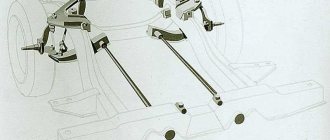Many novice drivers are interested in the question of what car restyling is, why it is needed and “what it is eaten with.” In simple terms, this concept means making changes to the appearance of the car. In Russia, many people call restyling the word “tuning”, although these terms differ in meaning. In the first case, changes are made to the interior and exterior of the car, and tuning is considered to be an improvement in the technical equipment of the car. There are other concepts that characterize making adjustments to a car in such a way that a more aggressive shape of the car appears. In this material it is worth considering the concept of restyling in more detail.
Restyling - what is it?
Restyling is a popular concept that has a lot of synonyms. For example, a facelift means the same as changing the style or updating the appearance. In relation to cars, this word is used in the sense of “modernize”. The vehicle body undergoes changes in terms of plastic and metal elements. The technical characteristics of the car are not affected in any way.
Today, the automobile market offers a wide selection of cars to suit every taste and budget. Restyling is carried out by manufacturers who want to diversify their model range with new “samples”. The brand makes adjustments to the appearance of the car, updating it and making it more modern.
There have been situations when, after a facelift, a vehicle received quite profound interior changes. For example, the model was equipped with a spoiler, became lowered, or was supplemented with sports body kits. The difference between the current and previous model turned out to be significant.
We can talk for a long time about fashion trends. But manufacturers carry out restyling for one reason - they want to sell the same car model again, only by refreshing its image. This is a marketing ploy that forces car enthusiasts to spend their money. To release a truly new car, the manufacturer will have to spend time and money developing the design and technical base. The restyled model already has a “basis”, which is supplemented with new “chips”. A year later, an updated version of the car appears on the market, which fans of the brand will happily buy.
Since there is great competition between manufacturers, many of them are simultaneously developing both the main and restyled models. This is done to prevent competitors from introducing other people’s “tricks” into their developments.
Does the mechanical part of a restyled car change?
When a certain model is updated three to four years after the start of production (this is approximately the middle of the production cycle of the model range), the automaker can make more significant adjustments compared to a cosmetic facelift.
So, another power unit can be installed under the hood of the model. Sometimes the motor range expands, and in some cases, one motor is replaced by analogues with different parameters.
Some car models are undergoing more significant updates. In addition to the new power units that are available starting with a specific restyled model, it may be equipped with a different braking system and modified suspension elements (in some cases the geometry of the parts changes). However, such an update is already bordering on the release of a new generation of cars.
Automakers rarely make such drastic changes; this mostly happens if the model has not gained popularity. In order not to announce the release of a new generation, marketers use the expression “the model has undergone deep restyling.”
Why is it needed?
Drivers do not always understand what restyling means in a car, because they think that it is easier for manufacturers to release a new generation model. But as practice shows, the opposite is true. Brands do this to increase sales without spending extra money on developing new cars. But this is not the only reason why restyling is taking place. Some manufacturers use it to correct errors.
Most often, a new car model has several modifications, each of which has its own engine type, gearbox, electronics and optics parameters. But there are situations when the weight of the engine is not compatible with the car, or is completely unsuitable for a particular market. That is why restyling is an ideal reason to remove an unsuccessful option from the line.
Why else do manufacturers resort to restyling? In fact, you need to understand that lull and lack of new products will lead the company to bankruptcy. Strong competition does not tolerate those who cannot offer customers something new and original. That is why the creators closely monitor keeping the technical content up to date. After 5-7 years, the new product released will no longer be of interest to buyers. Thus, they resort to restyling almost every year in order to stay afloat.
Examples of restyling of new cars
One of the brightest representatives of restyled modifications is the Mercedes-Benz G-class. Restyled modifications of the same generation appeared several times during the production of the model. Thanks to this marketing move, one generation was not updated during 1979-2012.
But even the 464th model, the release of which was announced in 2016, is not positioned as a new generation (although the company decided to close the generation on the 463 generation). Daimler called it a deep restyling of the 463 model.
A similar picture is observed in the case of VW Passat, Toyota Corolla, Chevrolet Blazer, Cheysler 300, etc. Although there is debate about the term deep restyling: can it really be called that if almost everything in the car changes except the nameplate. But regardless of the opinion of the author of this article, the manufacturer himself decides what to call the next new product.
Main reasons
The reasons for restyling may be fashion and style. These concepts are also present in the world of cars. Designers and engineers follow trends and try to comply with them. A typical example is the VAZ 21099 and its restyled version - “nine”. In those days, the manufacturer wanted to create a car for young people. I wanted buyers to get an inexpensive vehicle, but at the same time stylish and with the sporty characteristics of those years.
Another reason for the annual release of restyled models is strong competition. Brands are trying their best to meet the needs of car owners, so they are improving and modernizing their cars.
The same story happened with the aforementioned VAZ 21099. The domestic manufacturer did not develop a new car, since this would entail high costs. In order not to change the technical documentation, another number was added to the model name. Thus, buyers received a new product from the automotive industry, and the manufacturer received profit.
Bibliography[edit | edit code]
- Parashchuk S.V., Exterior // Encyclopedic Dictionary of Brockhaus and Efron: In 86 volumes (82 volumes and 4 additional). - St. Petersburg, 1890-1907.
- Design, Illustrated dictionary-reference book / G. B. Minervin, V. T. Shimko, A. V. Efimov. - M.: Architecture-S, 2004. - ISBN 5-9647-0021-7.
- Patricia Hart McMillan, Katherine Kayi McMillan.
Interior design for dummies = Home Decorating For Dummies. - M.: Dialectics, 2007. - ISBN 0-7645-4156-0. - Kiloshenko M. I. Psychology of fashion. - Onyx, 2006. - 320 p.
Kinds
As soon as the driver understands the essence of what restyling means in a car, he goes deeper into this concept. Today there are two types of restyling:
Planned - happens most often, since even the most modern and attractive car model loses relevance over time. Competitive companies are fighting for customers, so they offer more interesting options. Planned restyling forces manufacturers to release updated car models in order to retain customers.
Unscheduled - carried out in order to maintain sales of a specific car model. For example, after the car was released, buyers criticized its appearance, build quality, or commented on its ease of use. Manufacturers, in order to somehow justify themselves to customers, solve the problem through restyling.
Thus, restyling means an intermediate update of a car model. Specific changes occur when a generation changes (every 7-10 years).
What does the concept of restyling include?
Essentially, these are any innovations that in one way or another draw a line between a younger model and its predecessor, and also slow down the car’s obsolescence. Restyling can be anything. In some cases it is barely noticeable, while in others it represents numerous large-scale improvements of both a stylistic and technical nature. Rejuvenation allows cars to stay on the production line for another couple of years, although sometimes it’s time to talk about a much longer period.
Peculiarities
As mentioned above, restyling is sometimes forced, especially when failures are detected in any system. It happens that entire series are recalled, and buyers then wait for their compensation. This forces the manufacturer to lose money, so it equips service centers with all the necessary materials and software so that owners visit the service station and replace low-quality components along with a software update. Such situations occur extremely rarely, since they try to identify all the “jambs” during the production process.
The planned restyling is proceeding according to the planned scenario. Many companies have entire departments of specialists who follow new trends and fashion. Designers and engineers are developing a number of changes that will be implemented in the future. The manufacturer thus wants to be 100% sure that the buyer will receive exactly what he really wants. This forces it to withstand strong competition. When compiling a list of changes, everything is taken into account, from body colors to materials for “decorating” the interior.
They try to pay very close attention to the front of the car, adding chrome elements to it, or adjusting the appearance of the air intakes. Most often, from the rear, the car looks the same as it was originally. There are completely minor restylings when the car remains virtually unchanged. Owners can carry out this procedure themselves by purchasing covers for mirrors or headlights.
Types of car restyling
As for the types of restyling, there are two types:
- External renewal (often this type is called facelift - “facial skin tightening” or rejuvenation);
- Technical restyling.
Stylistic restyling
In this case, the company's designers are developing various modifications to the appearance of an existing model in order to give it freshness. Most often, brands resort to this type of update. Typically, manufacturers limit themselves to minor implementations that subtly hint that the car has received updates.
And sometimes designers get so carried away that the body even gets a separate numbering, as often happens with Mercedes-Benz and BMW cars. Less common is a significant change in appearance, since this procedure also requires funds and resources. The update may also include changes to the interior. Moreover, more often it undergoes much more changes than the body part.
Here is a small example of a minor restyling of a car:
Kia Rio: minimal restyling
Technical restyling
In this case, the procedure is often called homologation. This is a change in the technical part, but also without significant changes, so that the result is not a new model. For example, homologation includes expanding the range of engines, making some adjustments to the power units or electronics of the car, which improves its performance.
For example, some Ford models were not initially equipped with EcoBoost engines, but after restyling, such modifications become available to customers. Or in the period 2003-2010. The BMW 5-Series in the E-60 body received turbocharged analogues instead of naturally aspirated engines. Often such changes are accompanied by an increase in power of a popular model and a decrease in fuel consumption.
Often such “rejuvenation” is carried out several times during the production history of a model of one generation. Often technical restyling borders on the release of a new generation. An example of this is the two homologations of the Mazda 3. In addition to impressive cosmetic procedures, engines and even the chassis were changed. However, this is not the limit that the manufacturer can afford.











